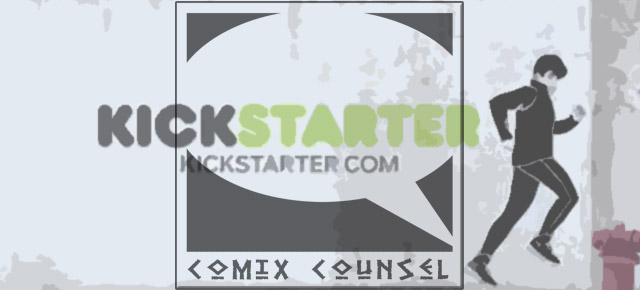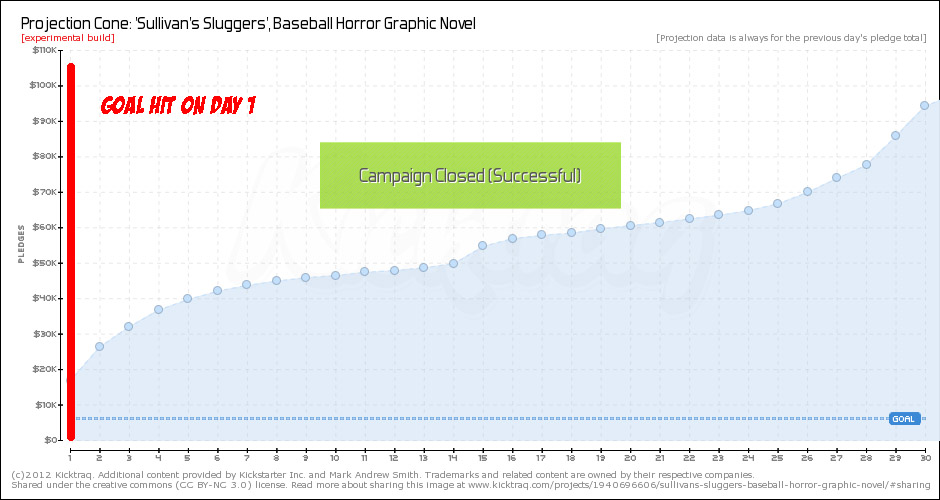Kickstarter: 10 Things I Think I Know…
I’ve written a fair amount about Kickstarter, most recently here in The Pre-Order Gauntlet (Or Why Kickstarter is Kicking Ass) and ComixTribe has covered the phenomenon in some detail (check out the Trenches article Successful Funding with Kickstarter by Nathan Hill.) Kickstarter is a fascinating development, an evolving beast, and something that I’ve studied with great interest. I think I understand it about as well as someone can…who has never actually run a campaign.
Well, that changes next week.
That’s right, next Monday, I’ll be launching a 30 day Kickstarter campaign for a project I’m extremely excited about. What’s the project? Well, if you’re on the ComixTribe Mailing List, you’ll find out and get a sneak peek later this week…the rest of you will have to wait until it launches.
In planning a campaign and the project it hopes to launch, I’ve done a tremendous amount of thinking about the Kickstarter phenomenon. For today’s post, I’m going to list 10 Things I THINK I Know about how this thing works. After the campaign is over, I’ll write a companion piece of things I learned or didn’t know before launching a campaign. So, here goes:
#10. Seth Godin gets it. (No surprises there.)
If you’re thinking about doing a Kickstarter, I strongly suggest you listen to this interview with Godin and read his post Why Some Kickstarter’s Fail. It’s no surprise Godin gets it, as most of the principles that Kickstarter was founded on seem to come straight from his insights. The most brilliant analysis of Kickstarter thus far is Godin’s observation that “Kickstarter looks like a shortcut. It’s not. It’s a maximizer.”
#9. The Comics Failure Rate is Significant
No one sets out to launch a Kickstarter campaign planning to fail…or so you would think. But according to Kickstarter’s own stats, a whopping 9% of all Kickstater comic projects FAIL TO GET A SINGLE PLEDGE. NINE PERCENT! How is that possible? Nine out of 100 people starting comic Kickstarter campaigns can’t even get their mom to toss them a few bucks?! Baffling. (On the bright-side, the comics category does better on that metric than the site average of 13% that raise zippo.) And while we hear a lot about funding success stories, the stats tell us that 54% of comic projects do not get funded. More than half who try…fail. That’s sobering to say the least.
#8. It’s Very Possible to Get Funded and Still Lose
Kickstarter is a great tool, but is dangerous in the hands of creative types who can’t do math. I’m seeing plenty of examples of the “Worst Case Success” phenomenon: Kickstarters that are successfully funded, but end up causing more pain (usually financial) for the creator than benefit. This usually happens when:
- The target goal hit was too low to adequately fund the project.
- The rewards were priced in such away that they cost nearly as much (or MORE) than the pledge level.
- No research into the actual cost of shipping was done. (Shipping is MUCH more expensive than you think!)
- Calculations were done on the gross goal total, not the net after Kickstarter fees, Amazon fees, and taxes.
Indie super-letterer and talented Murder Book scribe Ed Brisson wrote about his Indiegogo (a Kickstarter clone available to non-US residents) experience, and it seems Ed learned a lot of these lessons the hard way. Bottom line: Do the math and the research. A money goal based on ONE input (ie. printing the book) is not enough.
#7. Hitting Your Goal is No Longer Necessarily a Momentum Killer
In the “early days” of Kickstarter (funny, because in point #3 I argue that KS is still in its infancy), creators had a real tough decision to make regarding funding goals. You didn’t want to set a goal too high, because if you don’t get it, you get nothing. On the other hand, creators who set their target goal too low would see their project almost completely run out of steam once the goal was hit. And this makes sense. The “All or Nothing” nature of the KS funding platform meant that hitting that goal is paramount…and psychologically, once a goal was hit, there’s less incentive for people who were on the fence about contributing to your project.
Thankfully, savvy creators like Mark Andrew Smith (Sullivan’s Sluggers) and Rich Burlew (Order of the Stick) discovered that all you need to do to keep the momentum going on a project is to MAKE THE PROJECT BETTER once you’ve hit your initial goal. Smith raised $91,000 dollars above his goal and Burlew a mind-boggling $1,196,370 above his goal. They did it by adding new target goals, reward levels, and bonuses that incentivized continuing to spread the campaign beyond its initial target.
#6. Kickstarter is a Maximizer
When I first saw creators with an audience turning to Kickstarter, I wondered, “Why Kickstarter?” After all, people have been able to put Paypal buy or donation buttons on their own websites for a decade. Why not just run a campaign yourself?
And in truth, I’ve has some success with that. Near the end of my webcomic run of OVER, I successfully ran a pre-order campaign that raised enough to print the book, and did the same for Tears of the Dragon Volume I.
But Kickstarter adds value in three key ways:
A) It’s a SMOOTH experience. Why is Facebook still around and Myspace not? Plenty of reasons…but the clean, smooth experience of Zuck’s site probably has a lot to do with it. Kickstarter is perfectly designed to for its intended purpose: Tell a story and fund a project.
B) The “All-Or-Nothing” dynamic creates a ticking clock and high stakes situation that compels action.
C) A marketplace is developing there. While creators without an existing audience entering Kickstarter hoping to be discovered will largely be disappointed, more than $15 million is currently being pledged there. That is the very definition of a marketplace.
#5. This Isn’t Charity
Kickstarter is not about charity. It’s about helping bring something cool to life for both the artists and the consumer’s mutual gain. I’ve noticed that adding stories of being out of work, having financial woes, or needing Kickstarter success to put food on the table are turn offs.
Likewise, the projects that go nuclear seem to be those that are furthest along. Yes, it’s called Kickstarter…not Pre-Order-er…but as that marketplace is developing , we’re seeing people do comics shopping on Kickstarter. Strangers aren’t interested in your goals and dreams and helping you bring your project to life. But if your book is killer, and if consumers can see enough of it to want it, Kickstarter MAY just be the best damn way for an independent creator to sell certain products right now.
#4. If you’re going to do it wrong, you better have a rich daddy.
The transparency of Kickstarter campaigns is one of its most fascinating aspects. As such, there’s a ton of data to be analyzed and trends to uncover. For example, the numbers tell us the average successful Kickstarter campaign:
- Has a goal of $4,500.
- Runs for 30 days.
- Has a video that’s 2 minutes long.
- The most common pledge level is $25.
- Delivery of the product comes within 30 days of the projects end.
Now, obviously these are just averages, and successful projects have deviated widely from the above list. But, if you’re going to “do it your way” it probably helps to have a rich daddy.
#3. Kickstarter is still in its infancy.
If you’ve made it this far, you’re no stranger to Kickstarter. You’ve likely backed some projects, are thinking about doing one yourself, or have already. Hell, you might already be a bit sick of Kickstarter by now. There’s been speculation of the “Kickstarter Bubble” or impending “Kickstarter Fatigue.” And hey, if your Twitter feed is anything like mine, you know there are WAY too many comic book Kickstarter projects out there for you to fund and still put food on the table.
All that said, I believe you ain’t seen nothing yet.

Right now, you can still count the million dollar Kickstarters on a pair of hands. The “superstars” haven’t tapped into it yet. Sure, Amanda Palmer raised big chunk of money, but she’s hardly a household name. Just think what a Gaga or a Bieber could do?
You and I are tuned in. Most of the world still hasn’t discovered Kickstarter. But it coming…
#2. There is an Economy being built around Kickstarter.
Fact: Right now, $387,000 is currently pledged towards comic book projects on Kickstarter.
Kickstarter is definitely a #comicmarket game-changer, and one I’d argue is for the best. Four years ago, when Zuda Comics launched, the best thing about it was the amount of money it infused into the indie comic community. Essentially, every month DC/Warner Bros. was dishing out $5,000 in publishing cash split between 10 competitors and one contract to the winner worth $13,000. To go after such a prize, indie creators (myself included) were willing to put more skin in the game, and plenty of creative teams and new projects were started.
I see Kickstarter doing the same thing…only SO MUCH BETTER than Zuda ever could.
Additionally, expect more content and supporting sites to be built around the Kickstarter architecture. Sites like Kicktraq, which is an interesting Kickstarter monitoring site. Or Kickstarter related podcasts, like the wonderful Funding the Dream podcast.
Oh, and professional Kickstarter consultants and campaign managers. That’s like, a real thing now.
#1. It’s worth a shot.
“Initiative = happiness.”
I began with Godin, so I’ll end with Godin. Kickstarter is really about initiative. While financial barriers are by no means the only ones that stand between you or I and our comic related goals, they do exist. Where Kickstarter thrives is that it is a platform for people with a story, a vision, and a plan to make something happen can invite others to help make it so.
Next week, I launch a Kickstarter campaign of my own. In this space, I’ll write about MY approach to designing a (knock on wood) successful Kickstarter.
Discuss this Article in the ComixTribe Forums
Related Posts:
Category: Comix Counsel



















Comments (2)
Trackback URL | Comments RSS Feed
Sites That Link to this Post